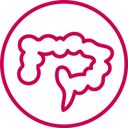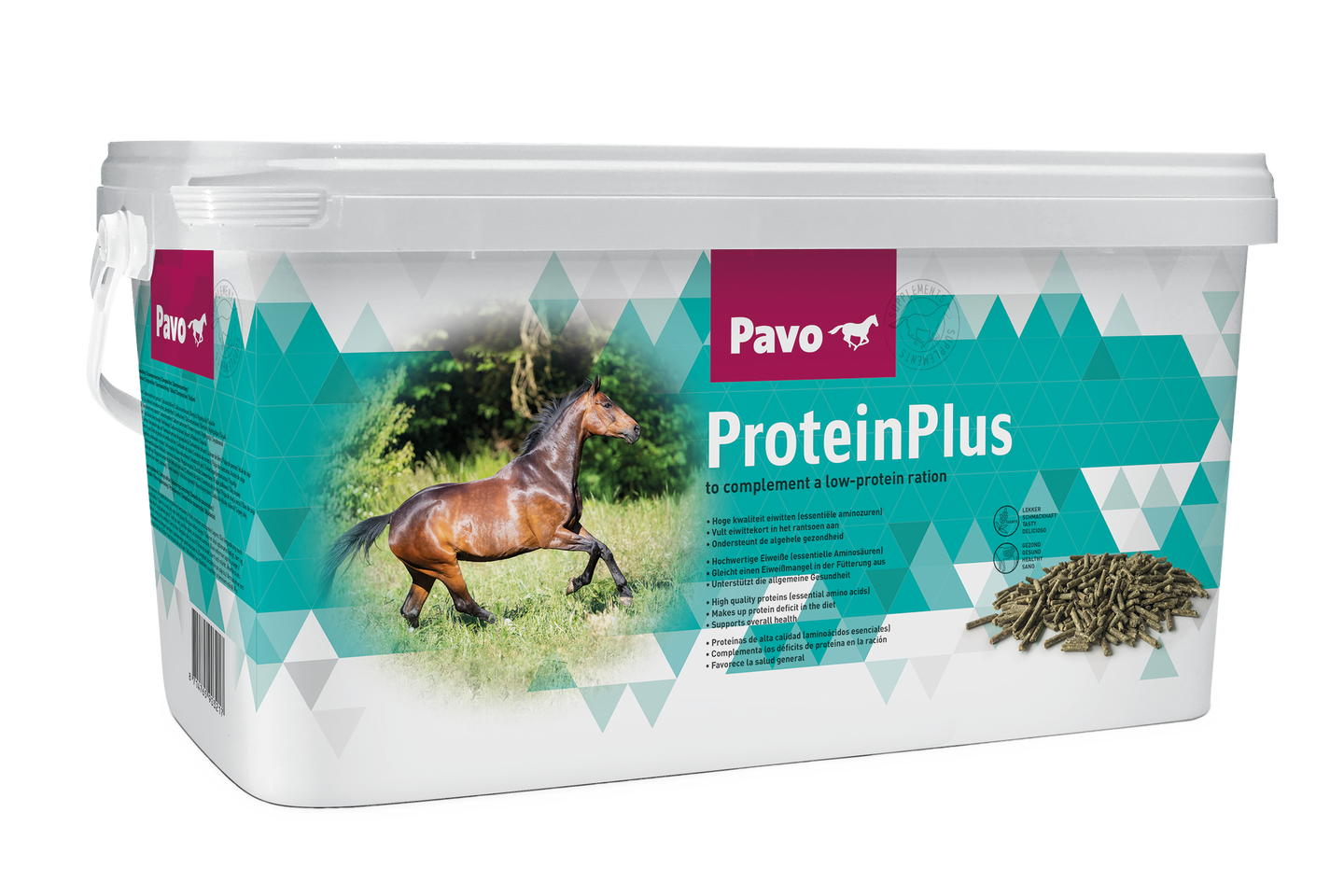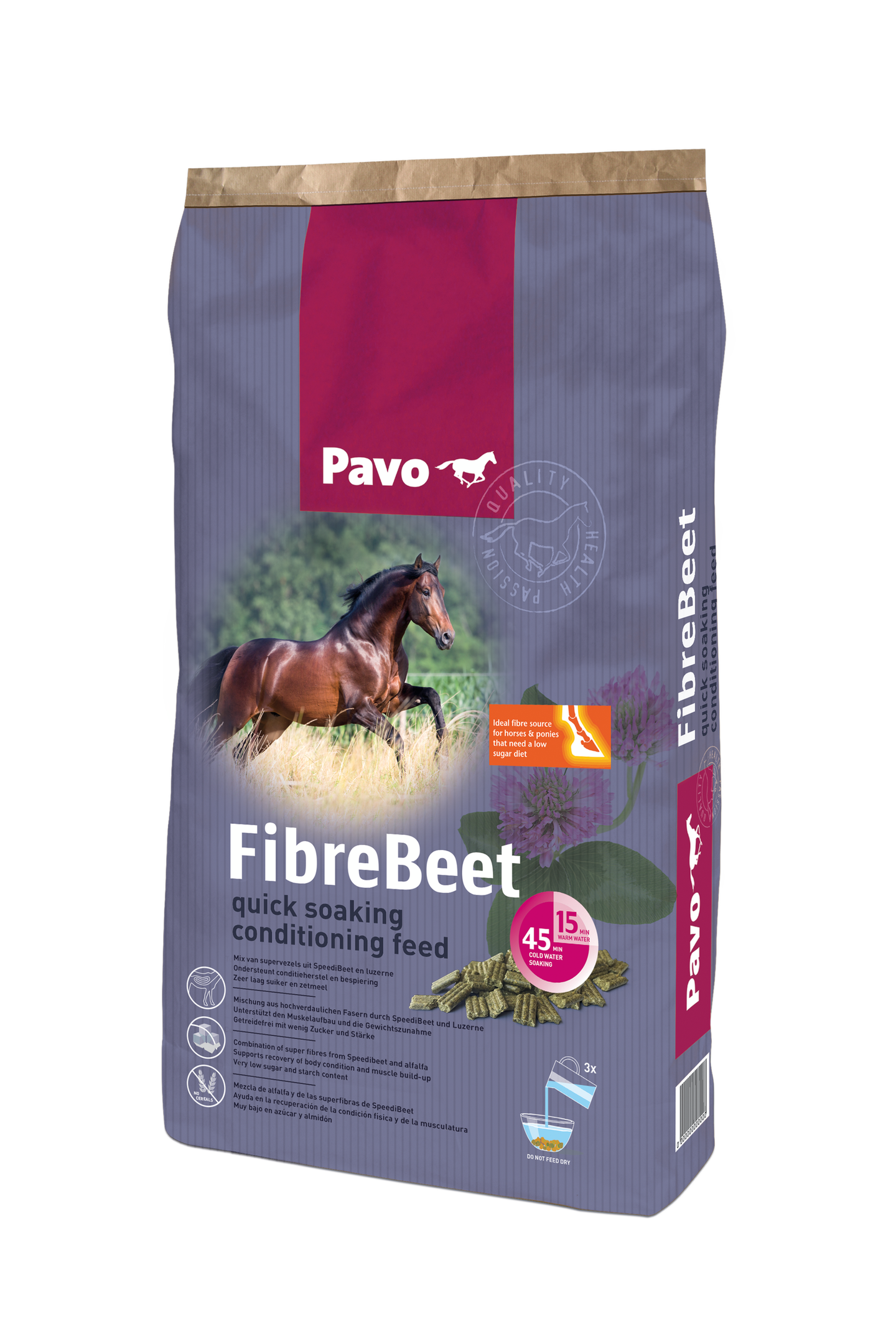Ook
jouw paard
kan
makkelijk aankomen

Digestive system
Check the manure structure of your horse

The digestive system of older horses works slower. They will also find it more difficult to absorb the nutrients from the feed. Older horses’ energy needs are therefore higher, as they digest food less effectively and absorb the nutrients offered less efficiently.
Older horses are more susceptible to colic and constipation compared to other horses. They are also more likely to suffer from more subtle symptoms of a less well functioning micro flora, such as manure water and thinner stools. Plus the oldies find it much harder to switch between different feeds compared to young horses. So if you decide to switch to a different (roughage) feed, make sure you initially mix it with the old feed.
A good dental function is important for digestion. Horses must grind their food into pieces smaller than 1 centimetre for the optimal functioning of the intestines. If they are no longer able to do this, it can result in deviating manure. This can include manure fluid, thin manure, colic, diarrhoea or blockages. Horses with a dicreased dental function ar nog capable of consuming long fibres (>3cm). You can feed Pavo SeniorFibre, all fibres in the SeniorFibre have a maximum lenth of 3 cm.
Pavo GutHealth has especially been developed to optimally support your horse’s digestion by bringing back the balance in the population of bacteria.
Coat shedding
Shedding costs your old horse a lot of energy

The shedding period will always take a great deal of energy out of your horse. Even more so for older horses, especially when the time comes for them to lose their winter coat. Fortunately you can help your horse get through this difficult shedding period with the right care and nutrition.
There are various different factors which can influence the shedding process. You can give your horse a helping hand with these five handy tips.
Tip 1: some good old brushin
Plenty of brushing and massaging your horse’s skin will result in excellent circulation and will allow the coat to shed more effectively. Plus your horse will love it too, as he’ll often be a lot more itchy during the shedding period. You can achieve a great deal with a rubber horse brush, but your brush will be full very quickly if your horse is shedding quite badly. There are special ‘foam blocks’ and rubber gloves with which you can easily remove loose hair.
Tip 2: exercise
Exercise is also an important factor during the shedding process. That’s because this results in better circulation. Why don’t you, for example, enjoy a nice walk with your horse.
Tip 3: extra protein
Your older horse will already have a greater need for protein, but even more so during the shedding period. That’s because protein is an important building block and plays an important role during shedding. The supplement Pavo ProteinPlus can help you horse. Also Pavo FibreBeet can help during this process, because of the high quality proteins which are processed from alfalfa and soy.
Tip 4: plenty of daylight
Daylight is the trigger for the shedding process. It’s therefore always a good idea to regularly put your horse out to pasture.
Tip 5: extra vitamins
You can give your old horse a boost if he is having trouble shedding. For example with Pavo MultiVit. Pavo MultiVit contains an extensive range of vitamins, antioxidants and prebiotics and is therefore a real ‘boost’ for your horse. This can give your horse just that little bit extra to guide him through the shedding process.
Tip 6: add Omega3
A dull coat or difficult shedding can be a sign of an omega 3 deficiency. Omega 3 is an important nutrient for improving the coat. As a horse cannot make omega 3 fatty acids itself, this must be provided through feed. You can give your for example horse Pavo OmegaFit or Pavo Linseedoil.
Does your horse have difficulty shedding and a curly coat? Then consider Cushing’s disease. You can read more about this on our page about common diseases in old horses.
Teeth
Recognize bad teeth in time

Dental problems are common in aging horses. Teeth which are falling out are naturally easy to recognise, but what are the other symptoms of bad teeth?
Horses can start to suffer from dental problems from the age of 15. You will notice a world of difference when you compare an older horse’s mouth with that of its younger counterparts. That’s because teeth and molars will continue to grow throughout their entire life.
Teeth and molars will wear down because they grind over each other while chewing. Unfortunately this wear doesn’t always happen equally. This can result in edges, sometimes also referred to as ‘hooks’. The molars will no longer slide over each other, so the horse will no longer be able to chew properly and will eventually lose weight. This can create large gaps between the teeth (diastasis), in which food can easily get stuck. This, in turn, can result in inflammation. This can sometimes cause teeth or molars to fall out, resulting in the opposite tooth growing too far.

“You will mainly see the teeth and not the molars when you look into a horse’s mouth. How bothersome the teeth are can differ enormously from horse to horse. It’s therefore important to have your older horse’s teeth checked at least twice a year by a specialist vet or a recognised dental professional”
Veerle Vandendriessche, nutritionist and veterinarian
Symptoms of dental problems:
- Taking a long time to eat
- Creating ‘clumps’
- Loss of fitness
- Quickly eating the concentrate (gobbling without chewing)
- Taking a long time to eat the roughage
- Oesophageal obstruction
- Drooling
- Nasal discharge
- Bad breath
- Jaw swelling

It’s important to adjust the feed to your horse’s dental condition. For horses with a reduced dental function we advice Pavo SeniorFibre. This is a easy-to-eat mix of (short) fibres and therefore can replace normal roughage like hay and silage.
You can read more about this on our page about roughage for old horses. We’ll go into more detail about the various different dental conditions and the type of roughage which suits them.
Joints
Movement is a must

Exercise is also an absolute must for older horses. It’s always a good idea to encourage your horse to move around. Older horses will often start suffering from joint wear and tear, also referred to as osteoarthritis.
This process actually already starts immediately after the birth of your horse. It will happen more quickly with some horses compared to others. Osteoarthritis could be to blame as soon as you notice your horse becoming somewhat stiffer or even start to walk with a limp. X-rays can be used to determine how far the process has progressed. If you're unsure whether osteoarthritis is to blame, it’ll always be a good idea to have some X-rays taken. That’s because it’s much better to be able to intervene at an early stage and keep the joint as calm as possible and subsequently slow down the process.
The most commonly affected joints are the hoof joint, the coronet joint and the pastern joint. It goes without saying other joints can be affected too.
Osteoarthritis can’t be cured. The only thing you can do is relieve the horse’s pain. The ultimate aim is for the horse to be able to enjoy being put out to pasture free from pain. Osteoarthritis treatment is aimed at reducing the inflammatory response in the joint.

”If you are in doubt whether atrosis is the cause of your horse becoming stiffer or no longer walking cleanly. Then always have x-rays made. In an early stage you can still slow down the process”
Veerle Vandendriessche, nutritionist and veterinarian
Therapy
The extent of the osteoarthritis will determine the treatment. Your vet may recommend an oral anti-inflammatory or painkillers if your horse is in a great deal of pain. Injecting the joint is an option too. But some special fittings or supplements are often very effective in the early stages. It’s also extremely important to keep your horse at a healthy weight, as being overweight will put unnecessary extra stress on the joints.
What can you do with food?
The condition of the cartilage, the synovial fluid and the ligaments of the capsule which hold a joint together can be positively influenced with the right nutrients. You can do this by adding a supplement to the ration. Pavo Mobility contains glucosamine and hyaluronic acid, which are components for healthy joint fluid. Chondroitin and MSM (sulphur) influence the cartilage. But these substances alone are not enough for horses. The most important thing is the special collagen which Pavo Mobility contains, which supports the connective tissue, bone and cartilage. It also contains vitamin C and the micro-mineral silicon, which plays a role in the formation of bone tissue, cartilage, collagen and hyaluronic acid.
Horses cannot create essential Omega fatty acids for themselves, though these are much needed for the proper functioning of their bodies. With Pavo OmegaFit you are providing a complete Omega 3-6-9 oil with an unparalleled high level of the most important Omega-3 fatty acids. These are critical for all sorts of processes within the body and support also the joints and mobility.

”The goal is that your horse with atrosis can eventually walk in the pasture pain-free”
Harrit van der Meer, Vet De Paardenkam
You can read more about keeping your horse in exercise on our page about training old horses.
Pavo HealthBoost
De krachtige opkikker voor ieder paard

Pavo HealthBoost contains a wide range of vitamins, antioxidants and prebiotics, making it a real boost for your horse. The natural vitamin E, in combination with the natural CellProtect antioxidants, provide an even better availability of vitamin E and the neutralisation of the free radicals. Immunity is closely related to a proper functioning of the digestive system. Live yeast is often used as a prebiotic that contributes to a healthy micro flora in the guts.
However, research has shown that live yeast loses much of its effectiveness by the processing into a product. This is why Pavo adds ‘Diamond V’ prebiotics to its HealthBoost. Diamond V contains nutrients that are required by healthy gut bacteria, allowing them to thrive.
No iron is added, as years of monitoring of the iron levels in roughage have shown that iron is available abundantly. Pavo HealthBoost does not contain wheat, so this supplement is also ideal for horses that are sensitive to gluten.
Important characteristics
- Powerful boost after sickness or a difficult period
- Supports the immune system and the intestinal health
- Contains vitamins, prebiotics and natural antioxidants
Application
- For horses that have been sick or have a weakened condition
- For horses that need support of their immune system
- For listless horses that could do with a bit of extra energy
- For horses that are for unknown reasons out of sorts
Feeding advice
- Give Pavo HealthBoost as a treatment during two to three weeks after sickness, or for a longer period of time for horses that suffer from a weakened immunity.
- Horse (approx. 600 kg): 250 grams per day
- Pony (approx. 300 kg): 125 grams per day
Pavo FibreNuggets
Pavo FibreNuggets as an alternative to roughage

Sufficient, high-fibre and high-quality roughage is the staple for every horse’s diet, however, this is not always self-evident. In some cases, it might be necessary to supplement or even replace your hay or silage wholly or partially. For example, in case of a poor or mediocre quality of roughage, or horses that suffer from teeth problems and consequently have difficulty taking in roughage.
Pavo FibreNuggets can be used as a high-quality replacement of roughage. The large high-fibre pellets, made from 100% pasture grass from the Alpine foothills in Southern Germany, stimulate chewing and salivation in your horse. More chewing prevents boredom and saliva promotes a healthy digestion. The fragrant and tasty pasture grass consists of a variety of more than 60 different types of grasses and herbs. It is rich in fibres, natural vitamins and trace elements and completely free of molasses and cereals. Thanks to a controlled drying process, the FibreNuggets are of a very consistent quality without mould or dust. This also makes it the ideal replacement for horses that are sensitive to dust and/or mould.
Important characteristics
- Top quality roughage replacement
- Tasty mixture of Alpine grasses and herbs
- Contains more than 60 different grasses and herbs
- Free of molasses and cereals
Application
- Suitable for all horses and ponies
- Supplement or whole or partial replacement of roughage in case of poor or bad roughage quality
- Senior horses or horses that have a problem with roughage intake due to teeth issues
- For horses that are sensitive to dust/mould in roughage
Feeding advice
- Pavo FibreNuggets can be fed dry, but for optimum safety we recommend soaking the pellets with sufficient water, in a ratio 1:2 (FibreNuggets : water). Soak the product for 30 minutes in hot water or 1 hour in cold water.
- Feed maximum 0.5 - 1 kg per 100 kg body weight per day.
1 full Pavo feed scoop FibreNuggets contains approximately 0.860 kg.
Pavo Mobility
Pavo FibreNuggets as an alternative to roughage

Optimum movement requires healthy joints. The right nutrients can have a positive effect on the condition of the cartilage, synovial fluid and the joint capsule and ligaments that keep the joint together.
Supple joints with Pavo Mobility
Pavo Mobility contains glucosamine and hyaluronic acid that are components for healthy synovial fluid. Chondroitin and MSM (sulphur) have a positive effect on the cartilage. On the cartilage yet these substances alone are not enough to support healthy joints in horses. The most important component is the special collagen in Pavo Mobility that supports the collagen, bone and cartilage. Pavo Mobility also contains vitamin C and the micro-mineral silicon that plays a role in the development of bone tissue, cartilage, collagen and hyaluronic acid. Pavo Mobility does not contain wheat, so it is gluten-free.
Important characteristics
- For supple joints
- Optimum nutrients for cartilage and joints
- Supports the creation of synovial fluid
- With collagen, glucosamine, chondroitin, hyaluronic acid, MSM and silicon
Application
- For horses that need support for their joints
- For competition horses
- For young horses that have just started their training
- For older horses
Feeding advice
Pavo Mobility can be administered as a preventative to competition horses when the joints are under a lot of strain. Additionally, Pavo Mobility can be given after an injury, if your horse had joint problems or upon indication of a veterinarian that your horse could benefit from it during a period of two to three months. Senior horses as well as horses with arthrosis may benefit from Pavo Mobility.
Preventatively:
Horse (approx. 600 kg): 50 grams per day
Pony (approx. 300 kg): 25 grams per day
As a treatment and for senior horses:
Horse (approx. 600 kg): 100 grams per day
Pony (approx. 300 kg): 50 grams per day











